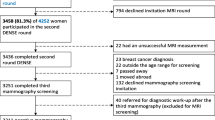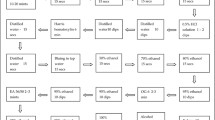Abstract
Purpose
To evaluate the effectiveness of a policy supporting early detection and prevention of cervical cancer among low-income and uninsured women by comparing women who reported never or rarely being screened (last screen >5 years) to those who reported screening in the past ≤5 years.
Methods
We analyzed data from 1,485,251 women who received their first Pap test in the National Breast and Cervical Cancer Early Detection Program (NBCCEDP) from July 2002 through June 2012. Of these, 461,893 women (31 %) reported being never or rarely screened and 1,023,358 (69 %) reported being screened in the past 5 years. Demographic (age, race/ethnicity, residence, and region) and clinic (cytologic and histologic results) characteristics were examined for the two groups.
Results
Women who were aged ≥50 years, Asian and Pacific Islander, American Indian or Alaska Native, multiracial, living in non-metro areas, or living in the South or a territory were more likely to report being never or rarely screened. The percentage of abnormal Pap tests and the rate of precancer and cancer (combined) was higher in the never or rarely screened group compared with the screened group (abnormal percentage: 2.9 vs 2.6 %, p value < 0.01; rate of precancer and cancer: 6.9 vs 3.7 per 1,000 women, p value < 0.01).
Conclusions
The priority of reaching never or rarely screened women should continue since those women who entered the NBCCEDP not adequately screened had a greater prevalence of high-grade histological lesions and invasive cervical cancers at later stages than women screened more recently.


Similar content being viewed by others
References
Scarinci IC, Garcia FA, Kobetz E et al (2010) Cervical cancer prevention: new tools and old barriers. Cancer 116:2531–2542
Group UCSW (2013) United States cancer statistics: 1999–2010 incidence and mortality web-based report. In: Institute CfDCaPaNC (ed). U.S. Department of Health and Human Services, Atlanta
Leyden WA, Manos MM, Geiger AM et al (2005) Cervical cancer in women with comprehensive health care access: attributable factors in the screening process. J Natl Cancer Inst 97:675–683
Sung HY, Kearney KA, Miller M, Kinney W, Sawaya GF, Hiatt RA (2000) Papanicolaou smear history and diagnosis of invasive cervical carcinoma among members of a large prepaid health plan. Cancer 88:2283–2289
Cancer screening—United States, 2010 (2012) MMWR. Morbidity and mortality weekly report. 61:41–45
Brown ML, Klabunde CN, Cronin KA, White MC, Richardson LC, McNeel TS (2014) Challenges in meeting healthy people 2020 objectives for cancer-related preventive services, National Health Interview Survey, 2008 and 2010. Prev Chron Dis 11:E29
Tangka F (2014). Cancer Causes Control
Wright TC Jr, Massad LS, Dunton CJ, Spitzer M, Wilkinson EJ, Solomon D (2007) 2006 consensus guidelines for the management of women with abnormal cervical screening tests. J Low Genit Tract Dis 11:201–222
Watson M (2015). Cancer Causes and Control
Moyer VA (2012) Screening for cervical cancer: U.S. preventive services task force recommendation statement. Ann Intern Med 156(880–91):W312
Saslow D, Solomon D, Lawson HW et al (2012) American Cancer Society, American Society for Colposcopy and Cervical Pathology, and American Society for Clinical Pathology screening guidelines for the prevention and early detection of cervical cancer. Am J Clin Pathol 137:516–542
USDA Rural–Urban Continuum Codes
Flagg EW, Datta SD, Saraiya M et al (2014) Population-based surveillance for cervical cancer precursors in three central cancer registries, United States 2009. Cancer Causes Control 25:571–581
Schiffman M, Wentzensen N (2013) Human papillomavirus infection and the multistage carcinogenesis of cervical cancer. Cancer Epidemiol Biomark Prev 22:553–560
Wright TC Jr, Stoler MH, Behrens CM, Apple R, Derion T, Wright TL (2012) The ATHENA human papillomavirus study: design, methods, and baseline results. Am J Obstet Gynecol 206(46):e1–e11
Bulletin AP (2003) Clinical management of guidelines for obstetrician–gynecologists. Number 45. Obstet Gynecol 102:417–427
Benard VB, Howe W, Saraiya M, Helsel W, Lawson HW (2008) Assessment of follow-up for low-grade cytological abnormalities in the National Breast and Cervical Cancer Early Detection Program, 2000–2005. J Low Genit Tract Dis 12:300–306
Saslow D, Runowicz CD, Solomon D et al (2002) American Cancer Society guideline for the early detection of cervical neoplasia and cancer. CA Cancer J Clin 52:342–362
Degroff A, Royalty JE, Howe W, Buckman DW, Gardner J, Poister T, Hayes N (2014) When performance management works: a study of the National Breast And Cervical Cancer Early Detection Program. Cancer 120(Suppl 16):2566–2574
Benard VB, Coughlin SS, Thompson T, Richardson LC (2007) Cervical cancer incidence in the United States by area of residence, 1998–2001. Obstet Gynecol 110:681–686
Watson M, Saraiya M, Benard V et al (2008) Burden of cervical cancer in the United States, 1998–2003. Cancer 113:2855–2864
Chen HY, Kessler CL, Mori N, Chauhan SP (2012) Cervical cancer screening in the United States, 1993–2010: characteristics of women who are never screened. J Womens Health (Larchmt) 21:1132–1138
Stanley SL, Thomas CC, King JB, Richardson LC (2014) Predictors of never being screened for cervical cancer by metropolitan area. J Community Health 39:400–408
Markowitz LE, Dunne EF, Saraiya M, Lawson HW, Chesson H, Unger ER (2007) Quadrivalent human papillomavirus vaccine: recommendations of the advisory committee on immunization practices (ACIP) MMWR. Recommendations and reports: morbidity and mortality weekly report. Recommendations and reports/Centers for Disease Control 56: 1–24
Murphy J, Kennedy EB, Dunn S et al. (2012) HPV testing in primary cervical screening: a systematic review and meta-analysis. Journal of obstetrics and gynaecology Canada: JOGC = Journal d’obstetrique et gynecologie du Canada: JOGC. 34: 443–52
Solomon D, Davey D, Kurman R et al (2002) The 2001 Bethesda System: terminology for reporting results of cervical cytology. JAMA 287:2114–2119
Massad LS, Einstein MH, Huh WK et al (2013) 2012 updated consensus guidelines for the management of abnormal cervical cancer screening tests and cancer precursors. Obstet Gynecol 121:829–846
Conflict of interests
The authors declared no potential conflicts of interest with respect to the research, authorship, and/or publication of this article.
Author information
Authors and Affiliations
Corresponding author
Additional information
The findings and conclusions in this report are those of the authors and do not necessarily represent the official position of the Centers for Disease Control and Prevention.
Rights and permissions
About this article
Cite this article
Benard, V.B., Royalty, J., Saraiya, M. et al. The effectiveness of targeting never or rarely screened women in a national cervical cancer screening program for underserved women. Cancer Causes Control 26, 713–719 (2015). https://doi.org/10.1007/s10552-015-0542-3
Received:
Accepted:
Published:
Issue Date:
DOI: https://doi.org/10.1007/s10552-015-0542-3




